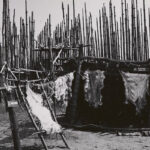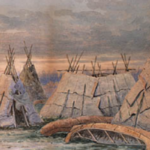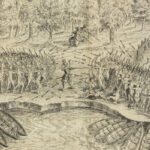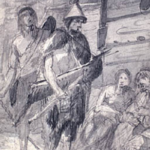The Tsleil-Waututh Nation: Stewards of the Burrard Inlet
The Tsleil-Waututh Nation, known as “People of the Inlet,” has lived along the Burrard Inlet in what is now the Greater Vancouver area for thousands of years. As part of the Coast Salish peoples, their history is one of profound connection to the land, water, and surrounding ecosystems. Through oral traditions, archaeological evidence, and historical research, the Tsleil-Waututh have preserved their cultural identity despite the challenges posed by colonization and urban development. Their story exemplifies resilience and a commitment to stewardship, making them key voices in shaping the future of their ancestral lands.
Ancient Origins: The People of the Inlet
The Tsleil-Waututh trace their ancestry back more than 4,000 years, rooted in the lands and waters of the Burrard Inlet and its surrounding forests, rivers, and mountains. Archaeological findings, such as shell middens, fish weirs, and ancient village sites, provide evidence of their long-standing relationship with the environment. The Burrard Inlet, rich in salmon, shellfish, and marine life, formed the foundation of their economy, spirituality, and community.
Keith Thor Carlson, in Living the River’s Legacy, notes, “The Tsleil-Waututh didn’t simply live along the inlet; they shaped it through sustainable practices that ensured its health and abundance for generations.”
Their name, Tsleil-Waututh, translates to “People of the Inlet,” reflecting the centrality of these waters to their identity. Oral histories describe the Burrard Inlet not only as a source of sustenance but as a place of deep spiritual significance, where the land, water, and sky are interconnected.
Governance and Social Structure
Before European contact, the Tsleil-Waututh had a sophisticated system of governance based on hereditary leadership, community consensus, and reciprocity. Extended families organized themselves around specific territories and resources, ensuring sustainable use and equitable sharing. Seasonal movements between fishing, hunting, and gathering sites allowed for the careful management of the inlet’s resources.
Historian Bruce Miller, in Paths of the Coast, emphasizes, “The Tsleil-Waututh’s social systems were finely tuned to the rhythms of the inlet, creating a balance between community needs and environmental stewardship.”
Potlatches were central to their cultural life, serving as opportunities to reaffirm social bonds, resolve disputes, and redistribute wealth. These gatherings also allowed for the preservation of oral histories, songs, and dances, which remain vital to their culture today.
Early Trade and Interactions
The Tsleil-Waututh were active participants in the extensive trade networks of the Coast Salish peoples. These networks connected communities across the Pacific Northwest, allowing for the exchange of goods such as dried salmon, cedar, and woven textiles. The Tsleil-Waututh also engaged in trade with neighbouring nations like the Squamish and Musqueam, forging alliances that strengthened their cultural and economic ties.
Jean Barman, in West Beyond the West, observes, “The Coast Salish trade routes were not just economic pathways but cultural lifelines, and the Tsleil-Waututh were vital contributors to this interconnected world.”
First Contact with Europeans
European explorers arrived in Coast Salish territory in the late 18th century, marking the beginning of a transformative era. Spanish naval expeditions, including those led by José María Narváez in 1791, were among the first to chart the Burrard Inlet. British Captain George Vancouver followed in 1792, documenting the region and its inhabitants.
Early encounters with Europeans were tentative but often involved trade. The Tsleil-Waututh exchanged salmon and other resources for metal tools and textiles. However, the arrival of Europeans brought devastating consequences, particularly in the form of disease. Epidemics such as smallpox decimated Coast Salish populations, with the Tsleil-Waututh experiencing significant losses.
Anthropologist Bruce Trigger, in Indigenous Peoples of Canada, writes, “The introduction of European diseases was an unintentional but catastrophic disruption to the social and cultural fabric of Indigenous communities like the Tsleil-Waututh.”
Colonization and the Loss of Land
The establishment of Fort Langley by the Hudson’s Bay Company in 1827 marked the beginning of sustained European settlement in the region. By the mid-19th century, the influx of settlers, driven by the Fraser River Gold Rush and later urban expansion, led to significant encroachment on Tsleil-Waututh lands. The imposition of Indian reserves under the Indian Act confined the Tsleil-Waututh to a small portion of their traditional territory, drastically altering their way of life.
Historian Robin Fisher, in Contact and Conflict, notes, “The establishment of Vancouver and the expansion of settler infrastructure turned the Burrard Inlet into an industrial hub, marginalizing the Tsleil-Waututh in their own homeland.”
Despite these challenges, the Tsleil-Waututh continued to maintain their cultural practices, fishing in the inlet, holding ceremonies, and passing down oral histories that preserved their connection to the land and water.
Cultural Resilience and Revitalization
Throughout the 20th century, the Tsleil-Waututh demonstrated remarkable resilience. They worked to preserve their traditions, language, and connection to the Burrard Inlet, even as urbanization transformed the region. Fishing remained central to their identity, despite restrictions imposed by federal fisheries policies.
Keith Thor Carlson, in The Power of Place, The Problem of Time, remarks, “For the Tsleil-Waututh, fishing was more than an economic activity—it was an assertion of their rights and a reaffirmation of their place in the inlet’s ecosystem.”
Artistic traditions, such as carving and weaving, flourished during this period. Many Tsleil-Waututh artifacts, now housed in museums, reflect the community’s enduring relationship with their environment and their ancestors.
Modern Stewardship and Advocacy
Today, the Tsleil-Waututh Nation is a leader in environmental stewardship and cultural preservation. They have become vocal advocates for the protection of the Burrard Inlet, opposing industrial projects that threaten its health. Through initiatives like the Tsleil-Waututh Stewardship Policy, they work to restore the ecosystems of their traditional territory while ensuring sustainable use.
The Tsleil-Waututh Cultural Centre serves as a hub for education and cultural revitalization, hosting programs that teach traditional knowledge, language, and art. Collaborations with local governments and organizations have strengthened their role as stewards of the land and water.
In A Concise History of Canada, Margaret Conrad writes, “The Tsleil-Waututh’s efforts to balance cultural preservation with contemporary challenges exemplify the resilience and innovation of Indigenous communities.”
Conclusion: Guardians of the Inlet
The history of the Tsleil-Waututh Nation is a testament to their enduring connection to the Burrard Inlet and their ability to adapt to profound changes while maintaining their cultural identity. From their ancient stewardship of the inlet to their modern advocacy for its protection, the Tsleil-Waututh continue to play a vital role in the cultural and ecological landscape of British Columbia.
As Jean Barman eloquently states in West Beyond the West, “The Tsleil-Waututh’s story is one of continuity and renewal, a reminder of the enduring strength of the People of the Inlet.” Through their traditions, their advocacy, and their commitment to future generations, the Tsleil-Waututh ensure that their history and identity remain integral to the story of Canada.
References
- Barman, Jean. West Beyond the West: A History of British Columbia. University of Toronto Press, 1996.
- Carlson, Keith Thor. Living the River’s Legacy: The Fraser River and Coast Salish History. McGill-Queen’s University Press, 2011.
- Conrad, Margaret. A Concise History of Canada. Cambridge University Press, 2012.
- Fisher, Robin. Contact and Conflict: Indian-European Relations in British Columbia. UBC Press, 1997.
- Harris, Cole. The Resettlement of British Columbia: Essays on Colonialism and Geographical Change. UBC Press, 1997.
- Ignace, Marianne and Ronald E. Ignace. Keeping the Stories Alive: Language, Land, and Culture in Indigenous Communities. University of Toronto Press, 2008.
- Miller, Bruce Granville. Paths of the Coast: Trade and Diplomacy in the Coast Salish World. University of Washington Press, 2005.
- Trigger, Bruce G. Indigenous Peoples of Canada. McGill-Queen’s University Press, 1992.



